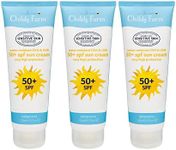Buying Guide for the Best Sunscreen For Kids
Choosing the right sunscreen for kids is crucial to protect their sensitive skin from harmful UV rays. Kids' skin is more delicate and can be more susceptible to sunburn and long-term damage, so it's important to select a sunscreen that offers effective protection while being gentle on their skin. When selecting a sunscreen, consider factors such as the level of sun protection, the type of sunscreen, and any additional skin sensitivities your child may have. Always test a small amount on your child's skin to ensure there is no allergic reaction before applying it more broadly.SPF (Sun Protection Factor)SPF measures how well a sunscreen can protect skin from UVB rays, the kind of radiation that causes sunburn and contributes to skin cancer. For kids, it's generally recommended to use a sunscreen with an SPF of at least 30, which blocks about 97% of UVB rays. Higher SPF values, like 50, offer slightly more protection, but no sunscreen can block 100% of UVB rays. If your child will be spending a lot of time outdoors, especially during peak sun hours, a higher SPF might be more suitable. However, reapplication every two hours, or after swimming or sweating, is crucial regardless of SPF.
Broad Spectrum ProtectionBroad spectrum sunscreens protect against both UVA and UVB rays. UVA rays penetrate the skin more deeply and are associated with aging and long-term skin damage, while UVB rays are the primary cause of sunburn. It's important to choose a sunscreen labeled 'broad spectrum' to ensure comprehensive protection. For kids, this is particularly important as their skin is more vulnerable to damage. Always check the label to confirm that the sunscreen offers broad spectrum protection.
Water ResistanceWater-resistant sunscreens are designed to maintain their SPF protection for a certain period while swimming or sweating. They are typically labeled as 'water-resistant' for either 40 or 80 minutes. If your child will be swimming or playing sports, a water-resistant sunscreen is a good choice. Remember, even water-resistant sunscreens need to be reapplied after the specified time, or sooner if your child is towel-dried.
Type of SunscreenSunscreens come in various forms, including lotions, sprays, sticks, and creams. Lotions and creams are often recommended for kids as they provide even coverage and are less likely to be inhaled compared to sprays. Sticks can be useful for applying sunscreen to the face, especially around the eyes. Choose a type that is easy for you to apply thoroughly and that your child is comfortable with. Consider the activity level and environment; for example, creams might be better for beach days, while sticks are convenient for quick touch-ups.
IngredientsFor kids, it's often recommended to use mineral-based sunscreens containing zinc oxide or titanium dioxide. These ingredients sit on top of the skin and physically block UV rays, making them less likely to cause irritation. Chemical sunscreens, which absorb UV rays, can sometimes cause skin reactions in sensitive skin. If your child has sensitive skin or allergies, look for sunscreens labeled as 'hypoallergenic' or 'fragrance-free'. Always check the ingredient list if your child has known sensitivities.
















